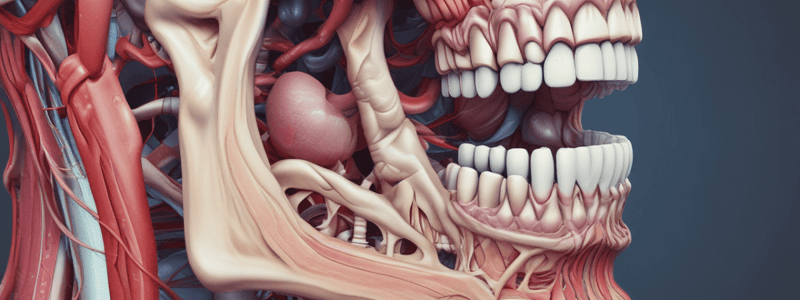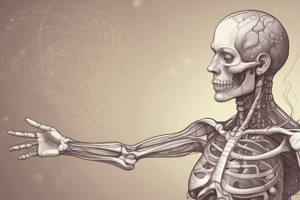Podcast
Questions and Answers
The vallecula epiglottica is an important landmark for the removal of palatine tonsils.
The vallecula epiglottica is an important landmark for the removal of palatine tonsils.
False (B)
The nasopharynx extends from the nasal cavity to the tip of the epiglottis.
The nasopharynx extends from the nasal cavity to the tip of the epiglottis.
False (B)
The larynx contains seven cartilages.
The larynx contains seven cartilages.
False (B)
The vocal folds have no role in vocalization.
The vocal folds have no role in vocalization.
The Eustachian tubes link to the larynx.
The Eustachian tubes link to the larynx.
Cilia are hair-like structures that help propel mucus away from the pharynx.
Cilia are hair-like structures that help propel mucus away from the pharynx.
The trachea extends to the level of the 7th thoracic vertebrae.
The trachea extends to the level of the 7th thoracic vertebrae.
The anterior and sides of the trachea are supported by 10-15 C-shaped cartilage.
The anterior and sides of the trachea are supported by 10-15 C-shaped cartilage.
The right bronchus branches at an angle of about 40-60 degrees.
The right bronchus branches at an angle of about 40-60 degrees.
The generation of bronchi continues until the diameter is less than 5-mm.
The generation of bronchi continues until the diameter is less than 5-mm.
Type I alveolar epithelial cells are the primary source of surfactant.
Type I alveolar epithelial cells are the primary source of surfactant.
The interstitium is a loose space that surrounds the bronchioles and primary lobule.
The interstitium is a loose space that surrounds the bronchioles and primary lobule.
Alveolar macrophages are responsible for gas exchange in the alveoli.
Alveolar macrophages are responsible for gas exchange in the alveoli.
The pores of Kohn permit gas to move between adjacent alveoli.
The pores of Kohn permit gas to move between adjacent alveoli.
Type II alveolar epithelial cells cover 95% of the alveolar surface.
Type II alveolar epithelial cells cover 95% of the alveolar surface.
The pulmonary circulation receives blood from the left heart at a flow rate equal to the entire blood volume each minute at rest.
The pulmonary circulation receives blood from the left heart at a flow rate equal to the entire blood volume each minute at rest.
The alveolar-capillary membrane controls only gas exchange in the lung.
The alveolar-capillary membrane controls only gas exchange in the lung.
The pulmonary circulation has high pressure and high resistance.
The pulmonary circulation has high pressure and high resistance.
The bronchial circulation supplies blood to the entire lung parenchyma.
The bronchial circulation supplies blood to the entire lung parenchyma.
The bronchial veins drain exclusively to the pulmonary veins.
The bronchial veins drain exclusively to the pulmonary veins.
Flashcards are hidden until you start studying




